You know a game is on the heavier end of the spectrum when there is a Further Reading section in the Play Book that points to numerous non-fiction works that speak directly to the subject matter in the game. You get a further indication that you will need to put in some serious effort when you realize that the Tutorial for the game clocks in at 21 pages, which is actually lengthier than the 19 pages of rules for the game. Comancheria: The Rise and Fall of the Comanche Empire, designed by Joel Toppen, takes a dedicated effort to learn to play, and even more effort to become familiar enough with to succeed, especially considering the game is a solitaire game. That effort, and the solitaire nature of the game, means that that Comancheria is only going to appeal to a small niche of people. If you are one of those people who fit into the Venn Diagram of solitaire board gamers who are interested in American History, especially history involving the First Peoples, there is an incredible amount of satisfaction and fun to be found here, and the theme is strong and deep enough that the Further Reading list ends up being more of a bonus than a source of intimidation.
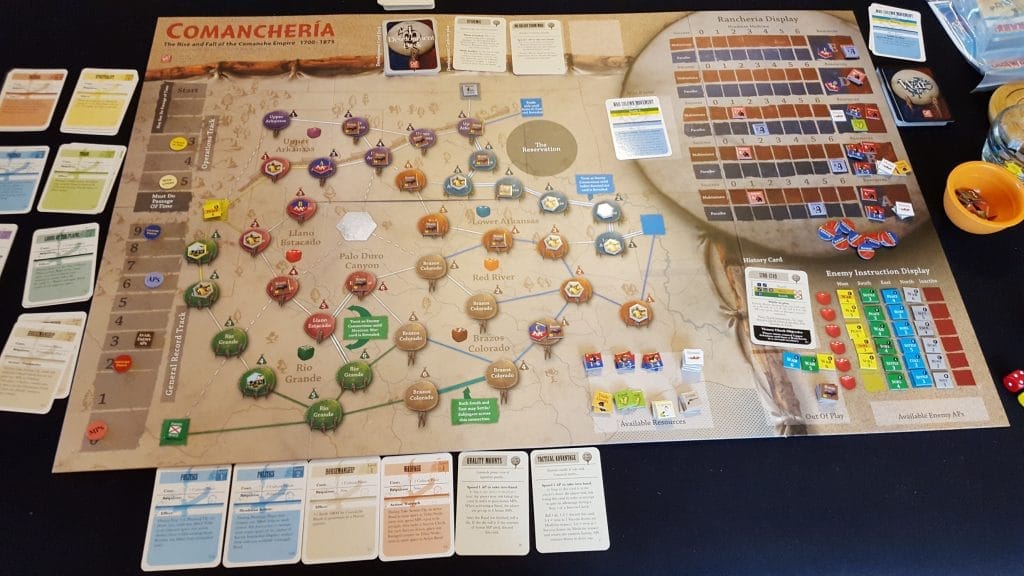
In Comancheria procedure is king. Outside of player decisions (which are numerous and robust; I'll get to that in a bit) nearly every aspect of the game follows a set procedure or a set of nested procedures. Learning these procedures, or at least learning to properly parse and apply them, makes up the bulk of the learning curve for the game. Thankfully Comancheria, like many of GMT's other excellent games, comes with a few player aids that assist in following these procedures that are accurate enough to keep you from making any mistakes that might derail a game in progress. The included tutorial does a wonderful job of walking you through each procedure that you will experience during play, and it hints at strategies that you will need to employ to be successful, but it can take time to learn them well enough to play without the player aids. I've played numerous times and I still use the player aid to ensure that I'm taking the right steps at the right times.
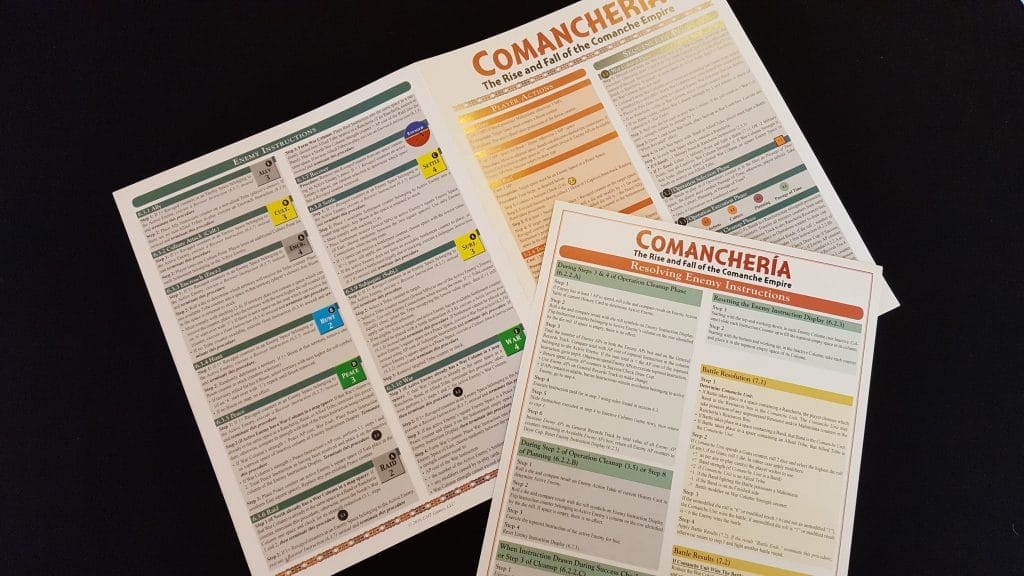
The decisions made by the player are really where the meat of the game (rightfully) lives and, while each of the four Operations that a player can choose to execute has a list of procedures that coincide with them, taking the right actions at the right time will make or break you in Comancheria. That's not to say that the game is solvable (it might be, but I'm far from seeing one solution that will carry the day every time) as there are enough random elements to make each play feel dynamic and unique. You may start this story in the same place every time, but the narrative weaves a different tale each telling.
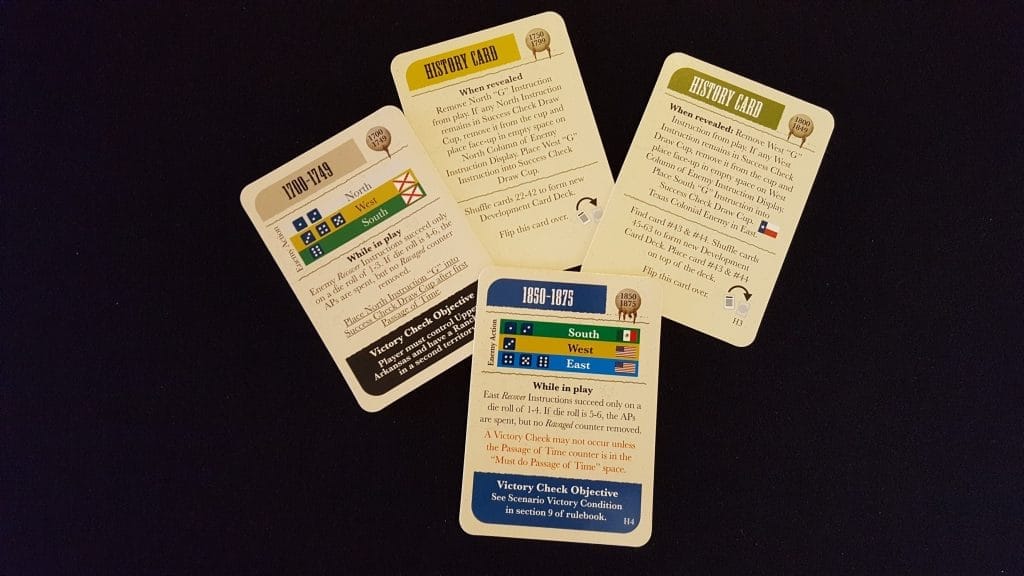
The primary means of randomization in Comancheria comes during Success Checks. These checks are made by drawing chits from the draw cup. If you are attempting to do something, the number of Success chits drawn determines how well you fare. The probabilities change constantly though, as Success chits are often kept out of the draw cup for at least a short amount of time after they are drawn. Mixed into the draw cup are Enemy AP chits that, when drawn, are added to a pool that determines how many actions the enemy AI will get to perform after the player turn has ended. The more often you dip into the draw cup before you can move Success chits back into it, the more likely you will empower your enemies to act against you, and the more successful you are in your endeavors, the further you will have to press your luck in order to keep making progress.
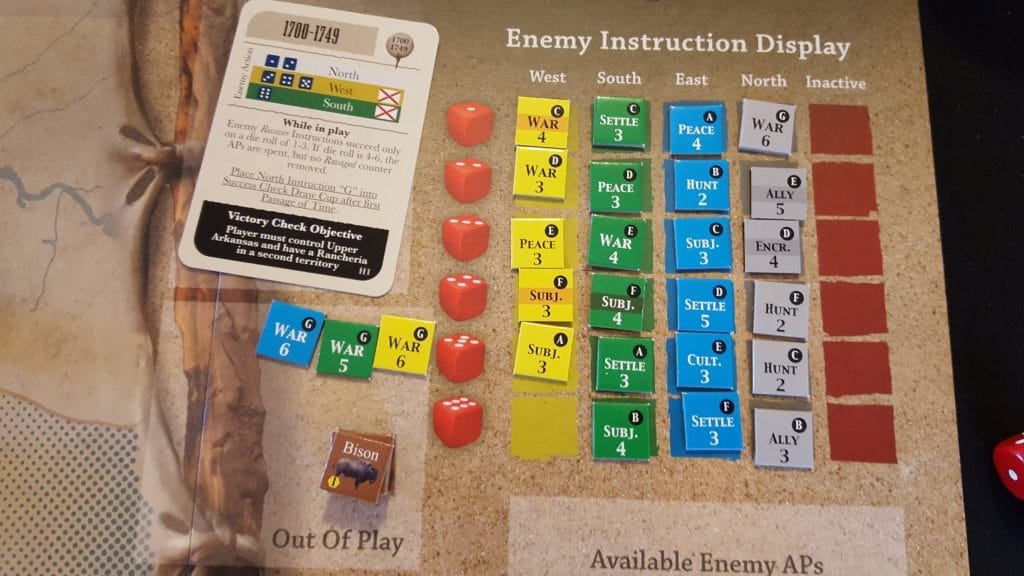
That balancing act gives the game a constant tension, especially since the AI is controlled by a dynamic Enemy Instruction Display. This display takes up the bottom right section of the board, and it shows you what each of your foes can do, and the order that they will do those things in. You can get a good indication of the behaviors you are enabling by your accrual of Enemy AP tokens, but your knowledge is never perfect because a die roll determines which enemy will activate each turn, and another die roll will flip one of the Enemy Instruction tokens (which are all double sided, most often with completely different actions on each side). Empowering your enemy with a deep AP pool is always dangerous, because you can never be sure of which enemy will act next, nor can you be exactly sure of what they will do.
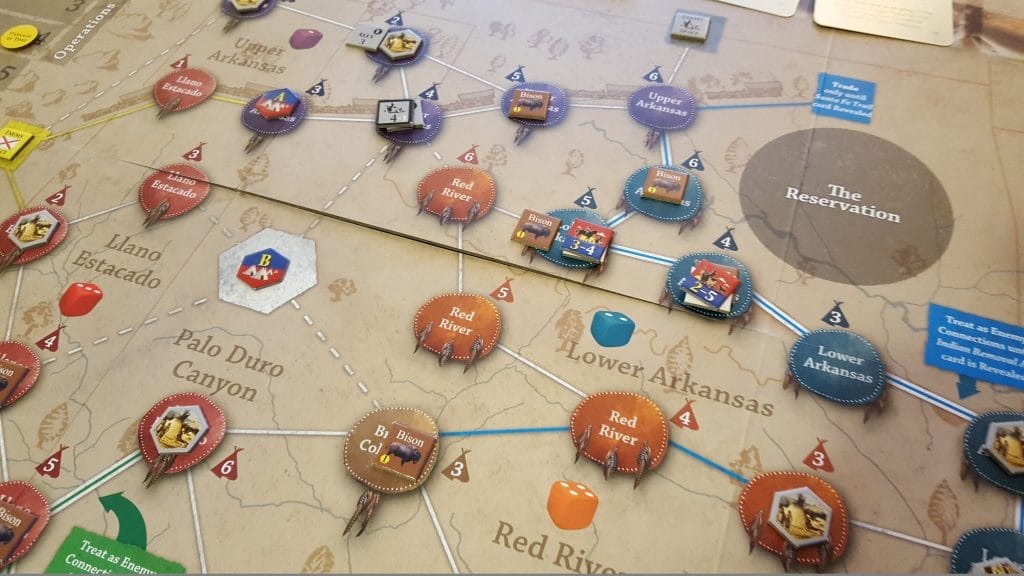
The most robust Operation that a player can take is to take Actions, which determines how you outfit your warbands, and what you will send them to do such as hunting bison, raiding enemy settlements and tribes for captives and food, and trading resources for other good. This is where the majority of your interaction with the draw cup exists, thus your main interaction with your enemies, but you also have to manage your tribe internally. Keeping your Culture strong in the face of the encroaching foreign threats is vital, as is using that Culture to develop new techniques and technologies, and giving the Mahimiana and Paraibo (each of your Rancherias' headmen) time to Plan and influence the game can make all the difference in future turns, as this is when you can directly influence Success chits that have been removed from play in order to get them back into the draw cup, and increase your Military presence.
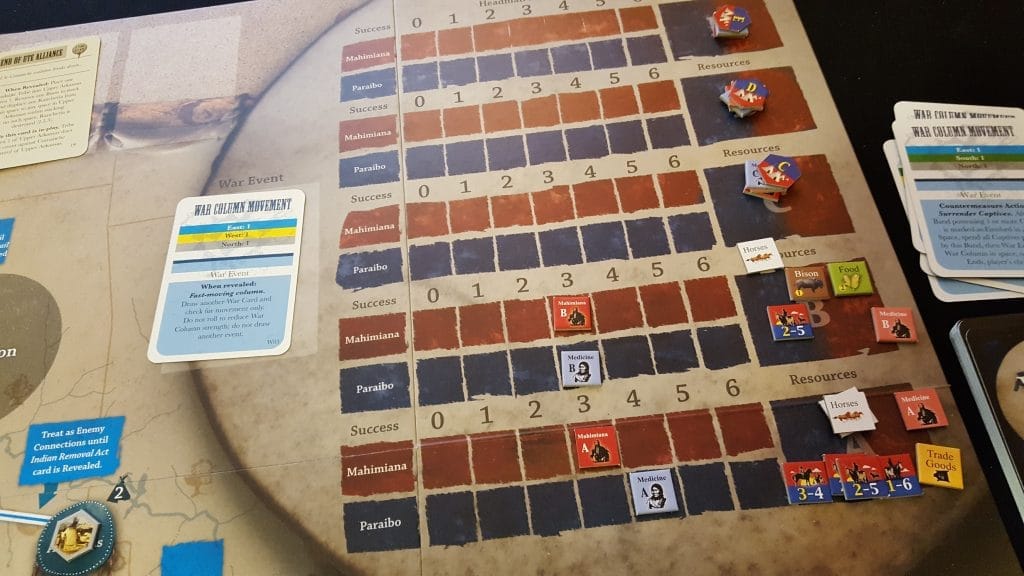
Eventually, be it by player choice or by the roll of the dice, you will face the Passage of Time. Here players can create new Rancherias, new bands, and make some crucial decisions about the future of their Mahimianas and Paraibos, or risk losing their tribe's headmen to old age. It's also during the passage of time where the most major results of the player's offensive raids are felt, and each enemy that is Ravaged is removed from the map. It's vital to stay on the offensive, because you lose Military points if you do not remove an enemy from the map during this Operation, and Military points are key for fighting against the AI's warbands. Additionally, if the player ever reaches zero Culture and Military points at the same time then the game ends immediately in defeat for the player. After the passing of enough time, players will have to begin to roll to determine if a Victory Check needs to be made. If it does, you compare the current game state to the victory condition on the current History card in play. If you satisfy all of the conditions for victory, you win, if not, you lose.
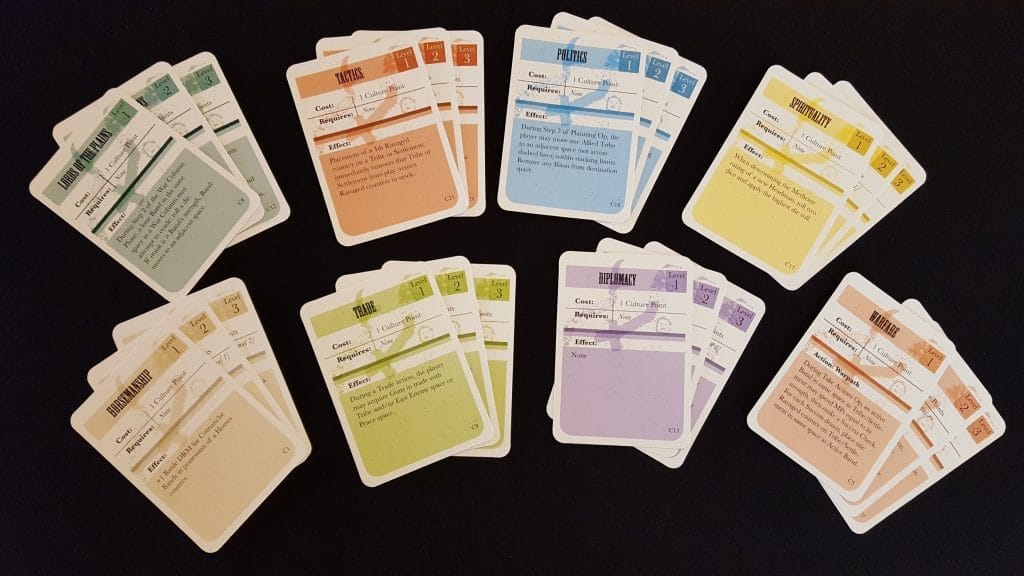
Comancheria has four scenarios, each of which encompasses a different period in history. The first, and easiest (and only scenario that I've managed to win so far) is a single period that represents the years 1700-1749. The second period also begins in 1700 but stretches out to 1799. The third takes place between 1800 and 1875, and the final scenario is all encompassing, taking the player from 1700 all the way through 1875. The difficulty ramps up from scenario to scenario, and a playing through all four historical periods is a daunting task, and while I have yet to successfully play through this scenario I would clock it at about 6 hours of playtime from start to finish, based on the pace that I play the game. You don't have to fret about setting that much time aside to play this game though, as even multiple plays of the same scenario feel different from one another, and even if you try to take exactly the same approach each time you play a scenario things will play out differently enough to keep things interesting.
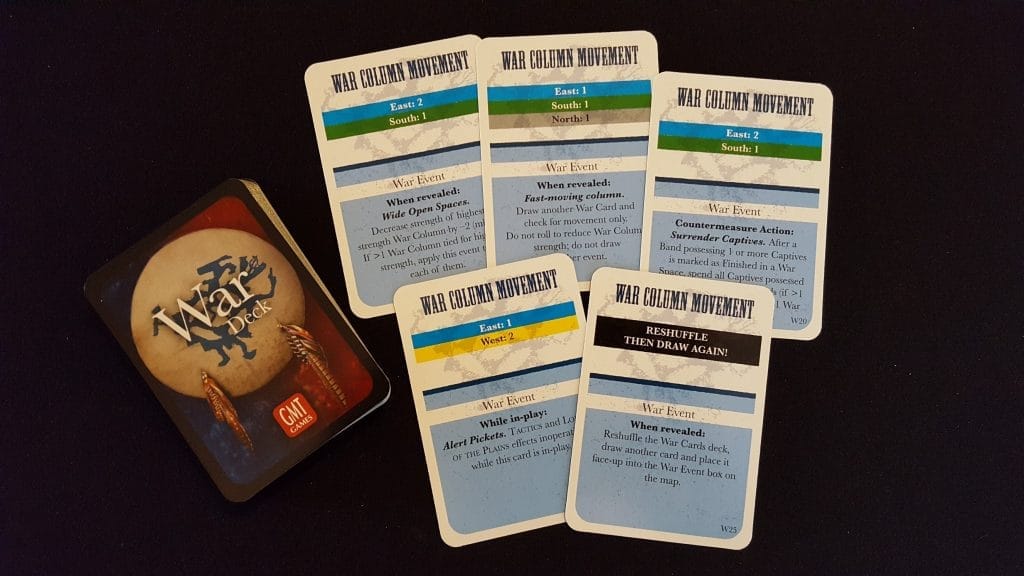
A note on chrome: GMT puts out games of exceptional quality and Comancheria is no different. Not only are all of the components, the board, player aids, and the rulebooks excellent, but GMT actually included an entire second set of Success/Enemy AP markers. That inclusion is wonderful, as those tokens are likely to be the component that wears out fastest due to the nature of how they are used. Bravo GMT!
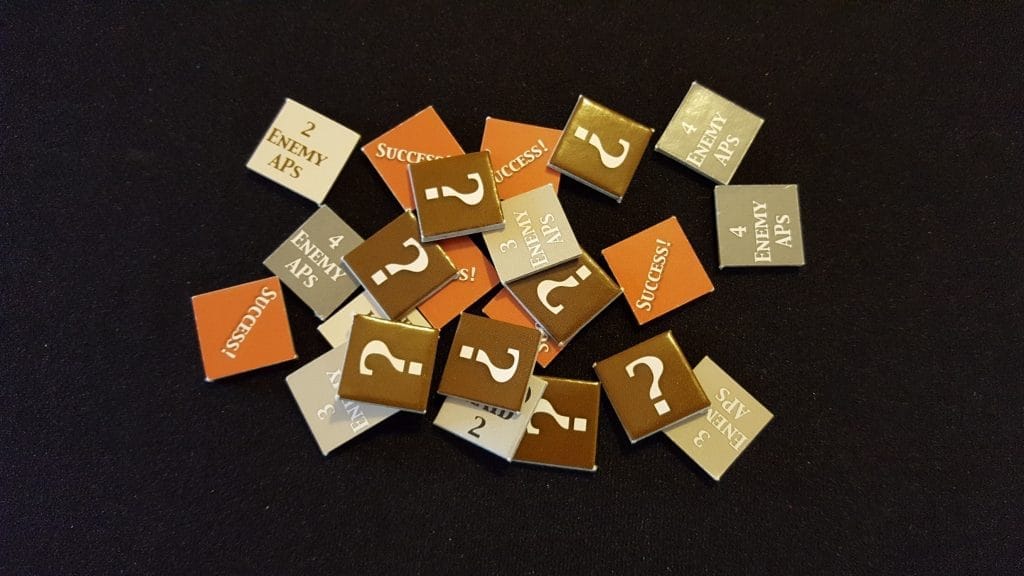
The bottom line:
Comancheria is big, dense and a touch intimidating. It takes effort to learn, but it is utterly rewarding once you make that effort. Think of this game like that novel that you've been wanting to read, but you've been putting off because of the time and effort you'll have to dedicate to it, even though you know that it will be worthwhile in the end. Like a great novel, playing Comancheria is a solitary experience, but the memories gained are satisfying, fun to look back on, and share with others. The best part of this novel is that you get to take an active part in its telling, and the choices you make will determine the outcome of the story. I couldn't recommend this game to someone brand new to board-gaming, for fear of them being overwhelmed by its procedures and complexity, but if you are already an experienced gamer, especially if you are also a fan of solitaire games, and American history, then Comancheria should definitely be on your radar.
Get this game if:
You like deep solitaire games.
You like American history, especially concerning the First Peoples.
You like complex, robust rules-sets that hinge on player choices.
Avoid this game if:
You are new to board gaming.
You shy away from games that last over an hour.
You prefer simple games.
The copy of Comancheria: The Rise and Fall of the Comanche Empire used for this review was provided by GMT Games.
Review Summary
If you are willing to put in the time and effort to learn all of Comancheria's procedures, you will be rewarded with an interesting, challenging experience that provides a huge level of satisfaction.
(Review Policy)Have a tip, or want to point out something we missed? Leave a Comment or e-mail us at tips@techraptor.net













